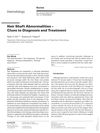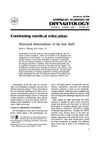TLDR Curved human hair has different structures on its convex and concave sides.
The study investigated the microstructure of curved human hair and found significant differences between the convex and concave sides. Fluorescein isothiocyanate permeated faster on the convex side, indicating structural differences. Transmission electron microscopy (TEM) showed smaller, dispersed macrofibrils on the convex side and larger, fused macrofibrils on the concave side. The alignment of intermediate filaments was helical on the convex side and parallel on the concave side. Amino acid analysis revealed lower Cys and higher Asp, Glu, and Gly on the convex side. These findings suggest similarities to the structure of ortho- and para-cortical cells in wool fibers, indicating a universal structure in curved mammalian hair.
65 citations
,
May 2006 in “Journal of Structural Biology” Hair curliness is due to uneven distribution of different cortices within the hair fiber.
22 citations
,
January 2006 in “Journal of Structural Biology” Hair follicles form hard α-keratin filaments in four steps, showing structural differences.
226 citations
,
January 2006 in “International review of cytology” Keratin-associated proteins are crucial for hair strength and structure.
100 citations
,
December 2002 in “Journal of biological chemistry/The Journal of biological chemistry” Researchers mapped and categorized specific keratin-associated protein genes on human chromosome 21q22.1.
175 citations
,
January 1995 in “Birkhäuser Basel eBooks” Human hair growth and structure are influenced by keratin proteins, genes, melanin, and lipids.
 44 citations
,
January 2005 in “Dermatology”
44 citations
,
January 2005 in “Dermatology” Hair problems can be caused by genetics or the environment, and treatment should focus on the cause and reducing hair damage.
 126 citations
,
January 1987 in “Journal of The American Academy of Dermatology”
126 citations
,
January 1987 in “Journal of The American Academy of Dermatology” The document concludes that understanding hair structure is key to diagnosing hair abnormalities and recommends gentle hair care for management.

